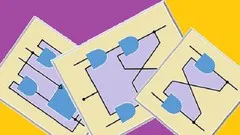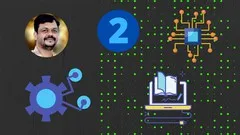
Flip Flops - from Introduction to Conversion 
Discover the world of flip-flops with the course "Flip Flops - from Introduction to Conversion." This comprehensive course takes you through the fundamentals of sequential circuits, latches, and flip-flops. Learn how to design truth tables, understand logic diagrams, and explore different types of triggering. Dive into the intricacies of SR, D, JK, and T flip-flops, and discover how to convert one type to another. With bonus videos on state tables, state diagrams, and more, this course is perfect for graduates, electronics engineers, and anyone interested in understanding the logic behind flip-flops. ▼
ADVERTISEMENT
Course Feature
![]() Cost:
Cost:
Paid
![]() Provider:
Provider:
Udemy
![]() Certificate:
Certificate:
Paid Certification
![]() Language:
Language:
English
![]() Start Date:
Start Date:
2020-05-22
Course Overview
❗The content presented here is sourced directly from Udemy platform. For comprehensive course details, including enrollment information, simply click on the 'Go to class' link on our website.
Updated in [September 27th, 2023]
What does this course tell?
(Please note that the following overview content is from the original platform)Introduction to Sequential CircuitsIntroduction to Latches and Flip-FlopsBasic SR Latch using NOR Gate: 1 Logic Diagram2 Designing Truth Table considering 4 Input combinationsBasic SR Latch using NAND Gate:1 Logic Diagram 2 Designing Truth Table considering 4 Input combinationsTypes of Triggering:1 Level Triggered a) Positive Level Triggered b) Negative Level Triggered 2 Edge Triggered a) Positive Edge Triggered b) Negative Edge TriggeredIntroduction to Flip-FlopsUnderstanding the LOGIC Diagram of level Triggered Flip-Flops1 SR Flip-Flops a) Indeterminate State in SR Flip-Flops 2 D Flip-Flops 3 JK Flip-Flops a) RACE-AROUND condition in JK Flip-Flops 4 T Flip-FlopsDesigning of Truth Tables of Flip-Flops: 1 SR Flip-Flops 2 D Flip-Flops 3 JK Flip-Flops 4 T Flip-FlopsCharacteristic Equation of Flip-Flops using K-Map Simplification:1 SR Flip-Flops2 D Flip-Flops 3 JK Flip-Flops 4 T Flip-FlopsExcitation Table of Flip-Flops:1 SR Flip-Flops2 JK Flip-Flops3 D Flip-Flops4 T Flip-FlopsConversion of one type of Flip-Flop to another Type:1 D to T Flip-Flop 2 JK to SR Flip-Flop 3 SR to JK Flip-Flop 4 T to D Flip-Flop 5 SR to D Flip-Flop 6 JK to T Flip-FlopBonus Videos(5) for Our Students1 Analysis of Clocked Sequential Circuits 2 State Tables3 State Diagram4 Clocked D&TFlip-Flops explainedThis course has been designed to understand the logic behind flip-flops their truth tables characteristics equations and explains conversion from one flip-flop to another Useful for graduates&electronics engineers and more
We considered the value of this course from many aspects, and finally summarized it for you from two aspects: skills and knowledge, and the people who benefit from it:
(Please note that our content is optimized through artificial intelligence tools and carefully reviewed by our editorial staff.)
What skills and knowledge will you acquire during this course?
During this course, the learner will acquire the following skills and knowledge:
1. Introduction to Sequential Circuits: The learner will gain an understanding of sequential circuits and their importance in digital electronics.
2. Introduction to Latches and Flip-Flops: The learner will learn about latches and flip-flops, which are fundamental building blocks of sequential circuits.
3. Basic SR Latch using NOR Gate: The learner will learn how to design a basic SR latch using a NOR gate, including creating the logic diagram and truth table for different input combinations.
4. Basic SR Latch using NAND Gate: Similar to the previous topic, the learner will learn how to design a basic SR latch using a NAND gate.
5. Types of Triggering: The learner will understand the different types of triggering in sequential circuits, including level-triggered and edge-triggered, both positive and negative.
6. Introduction to Flip-Flops: The learner will gain an understanding of flip-flops and their role in sequential circuits.
7. Understanding the Logic Diagram of Level Triggered Flip-Flops: The learner will learn how to interpret and analyze the logic diagram of level-triggered flip-flops.
8. SR Flip-Flops: The learner will understand the operation of SR flip-flops, including the concept of an indeterminate state.
9. D Flip-Flops: The learner will learn about D flip-flops and their characteristics.
10. JK Flip-Flops: The learner will gain knowledge about JK flip-flops, including the concept of a race-around condition.
11. T Flip-Flops: The learner will understand the operation and characteristics of T flip-flops.
12. Designing Truth Tables of Flip-Flops: The learner will learn how to design truth tables for different types of flip-flops, including SR, D, JK, and T flip-flops.
13. Characteristic Equation of Flip-Flops using K-Map Simplification: The learner will learn how to derive the characteristic equation of flip-flops using Karnaugh maps.
14. Excitation Table of Flip-Flops: The learner will understand how to create excitation tables for different types of flip-flops.
15. Conversion of one type of Flip-Flop to another Type: The learner will learn how to convert one type of flip-flop to another, such as D to T flip-flop, JK to SR flip-flop, and more.
Bonus Videos:
16. Analysis of Clocked Sequential Circuits: The learner will gain knowledge about clocked sequential circuits and their analysis.
17. State Tables: The learner will understand how to create state tables for sequential circuits.
18. State Diagram: The learner will learn how to create state diagrams for sequential circuits.
19. Clocked D&T Flip-Flops explained: The learner will gain a deeper understanding of clocked D and T flip-flops and their operation.
Who will benefit from this course?
This course will benefit individuals who are interested in or working in the field of electronics engineering. Specifically, it will be useful for graduates and electronics engineers who want to understand the logic behind flip-flops, their truth tables, and characteristic equations.
The course covers various types of flip-flops, including SR, D, JK, and T flip-flops, and explains their design and functioning. It also teaches how to design truth tables for different types of flip-flops and how to simplify their characteristic equations using K-Map simplification.
Additionally, the course includes bonus videos on topics such as analysis of clocked sequential circuits, state tables, state diagrams, and explanations of clocked D&T flip-flops. These topics are valuable for individuals who want to deepen their understanding of sequential circuits and their applications.
Course Syllabus
Introduction to Sequential Circuits
Introduction to Latches and Flip-Flops
Basic SR Latch using NOR Gate
Basic SR Latch using NAND Gate
Types of Triggering
Flip-Flop - Gated SR Latch
Gated D Latch - Level Triggered D Flip-Flop
Gated JK Latch - Level Triggered JK Flip-Flop
T Flip-Flop with Case 1 ( T =0, Enable =1)
Excitation table of various Flip-Flops ( SR, JK, T & D)
Conversion of One Type of Flip-Flop to Another Type of Flip-Flop
New Bonus Videos-Analysis of Clocked Sequential Circuit,State Table/Diagram,etc.
Course Provider

Provider Udemy's Stats at AZClass
Discussion and Reviews
0.0 (Based on 0 reviews)
Explore Similar Online Courses

Become a Professional Real Estate Photographer under 2 Hours

PCI Geomatics - Creating seamless mosaics from Air photos

Python for Informatics: Exploring Information

Social Network Analysis

Introduction to Systematic Review and Meta-Analysis

The Analytics Edge

DCO042 - Python For Informatics

Causal Diagrams: Draw Your Assumptions Before Your Conclusions

Whole genome sequencing of bacterial genomes - tools and applications

The Ultimate : Digital System Design ( Module - 1)

CMOS Digital Integrated Circuit Design


Start your review of Flip Flops - from Introduction to Conversion